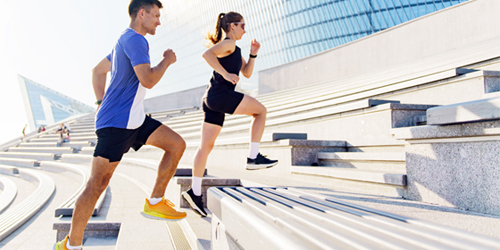BY MARK KINI
Several years ago, I used to run the stairs at Harvard Stadium every Wednesday at 5 a.m. I would leave my house an hour before to head into Boston, and every time I would question my sanity. I was inspired by the November Project, a grassroots movement that began in Boston in 2011 to encourage staying active during the frigid months in New England. It has now spread to more than 50 cities worldwide (and online) for free weekly workouts for all levels, including the Harvard stairs.
 The stadium stairs are a great workout, and I was in the best shape of my life. More importantly, there were people (and dogs!) of all ages and fitness levels supporting each other. Some elite athletes finished the stadium in record times, while others simply walked them. There was a genuine camaraderie and sense of accomplishment when we were done. More importantly, I always wound up feeling happy that I went.
The stadium stairs are a great workout, and I was in the best shape of my life. More importantly, there were people (and dogs!) of all ages and fitness levels supporting each other. Some elite athletes finished the stadium in record times, while others simply walked them. There was a genuine camaraderie and sense of accomplishment when we were done. More importantly, I always wound up feeling happy that I went.
Walking or running up stairs is one of the simplest yet most effective ways to improve cardiovascular health and build strength, as well as boost lung capacity and enhance blood circulation. This natural exercise targets the lower body muscles, particularly the glutes, quads, hamstrings, and calves, providing a great workout for muscle toning and endurance. Because stair climbing engages multiple large muscle groups, it also increases heart rate, boosting cardiovascular health and helping to improve overall fitness. Whether it’s a quick sprint up a flight of stairs, a steady pace, or a mix up, this form of exercise can be easily incorporated into daily routines, requiring no special equipment and offering a powerful calorie-torching workout.
In addition to its heart and muscle benefits, climbing stairs offers a unique metabolic boost. The intensity of stair climbing, especially when running, forces the body to work harder than flat ground walking, which means more calories are burned in less time. This makes it an efficient exercise for those looking to shed some pounds or maintain a healthy weight. The higher intensity can also stimulate fat burning, which is crucial for body composition improvement. Stair climbing is often referred to as a “compound exercise,” as it works several muscles at once, making it a time-effective way to achieve a full-body workout (as long as you are using good form and posture to avoid injuries).
Using a stair machine like the StairMaster at the gym offers similar benefits to walking or running up stairs, with the added advantage of adjustable intensity levels. This machine mimics stair climbing while providing controlled resistance and different speeds, allowing users to fine-tune their workout based on fitness levels. It also provides a low-impact alternative for those who want to avoid the stress that running or higher-impact activities might put on their joints. This equipment allows for longer, more sustained sessions, which can improve stamina and endurance over time, although you will definitely have to work up to it. It also offers different modes like interval training, providing even more variety in your sweat session, and can be a great option for those seeking a consistent and manageable way to integrate cardio into their routine. It’s intense for beginners, but you’ll have a definite sense of accomplishment after regular use. You will sweat.
Finally, both stair climbing and using a stair machine offer excellent benefits for mental health. Regular cardiovascular exercise has been shown to reduce stress, anxiety, and depression by releasing endorphins, which are the body’s natural mood boosters. The rhythmic nature of the exercise can also be meditative, allowing individuals to focus on their breathing and movement, clearing their mind while simultaneously benefiting from a full-body session. Whether in the gym or outdoors, taking the stairs can be a simple and accessible way to enhance both physical and mental well-being.
If you’re reluctant to give it a try, keep this in mind: The elevator to health success is out of order; you’ll have to use the stairs. [CD0425]
Mark Kini is the President & CEO of Boston Chauffeur. He can be reached at mark@bostonchauffeur.com.


